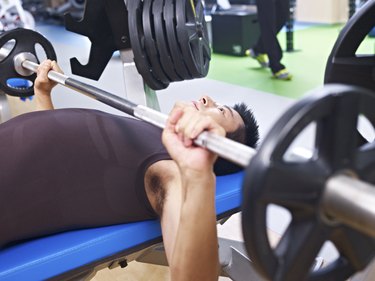
Compound exercises such as the squat and deadlift work your body using multiple joints and muscle groups. Isolation exercises use a single joint, and place fewer demands on your body's recovery ability. Compound exercises build size, strength and power while improving athleticism. No form of exercise will allow you to build muscle unless your diet supports your training program. Consult your physician before beginning any diet or exercise program.
Lower-Body Compound Exercises
Video of the Day
Exercises such as the squat and deadlift work your lower body extensively, but also work your core. The deadlift also works your upper back. Stiff-legged deadlifts work your hamstrings, the muscles on the back of your legs, more than conventional deadlifts, but recruit less of the front of your legs. Between these three exercises alone you can effectively work the majority of your lower body, your back and your abdominal muscles. Even your obliques, the muscles at the sides of your waist, are used to stabilize your torso when squatting and deadlifting.
Video of the Day
Upper-Body Compound Exercises
Chinups and rows both work your back, biceps and shoulders. Each type of exercise works your muscles through a different plane of movement, and there are small differences in activation in the middle of your back on some types of chinups and rows. The bench press works your chest, shoulders and triceps, with your triceps being the most active muscle in the bench press. The military press works your shoulders, trapezius and triceps. Between the seven exercises listed, you can work your entire body and work it heavily.
Compound Exercises for Size
To train for size and strength you need to train hard and heavy. Keep your repetitions low, no more than eight per set. Keep your total volume low, no more than five sets per exercise. If, after five heavy sets of squats, stiff-legged deadlifts, chinups, rows, bench presses and military presses you still have energy left, you are not training hard enough. Train your entire body every workout, but give yourself at least one day of rest in-between training sessions. You train in the gym, you grow outside of it.
Diet
To grow you need protein, possibly twice as much as a sedentary individual. You also need fats, including essential fatty acids, such as oily fish, which are also high in protein. Essential fatty acids are required for your muscles to recover and grow. Protein should also provide some fat, so whole foods such as beef, chicken, milk and eggs should be dietary staples. You need carbohydrates to help recover from workouts and provide energy for future training sessions. Get your carbohydrates from fruits, vegetables and whole grains.
- "Journal of Strength and Conditioning Research"; An Electromyographical Comparison of the Squat and Knee Extension Exercises; J.F. Signorile, et al.; August 1994
- "Medicine and Science in Sports and Exercise"; An Electromyographic Analysis of Sumo and Conventional Style Deadlifts; R.F. Escammila, et al.; April 2002
- "International Journal of Sports Physiology and Performance"; Hamstring Activation During Lower Body Resistance Training Exercises; W.P. Ebben; March 2009
- "Dynamic Medicine"; Variations in Muscle Activation Levels During Traditional Latissimus Dorsi Weight Training Exercises: an Experimental Study; George J. Lehman, et al.; June 2004
- "Journal of Strength and Conditioning Research"; Comparison of Different Rowing Exercises: Trunk Muscle Activation and Lumbar Spine Motion, Load, and Stiffness; C. M. Fenwick, et al.; August 2009
- "Journal of Strength and Conditioning Research"; Effects of Variations of the Bench Press Exercise on the EMG Activity of Five Shoulder Muscles; 1995